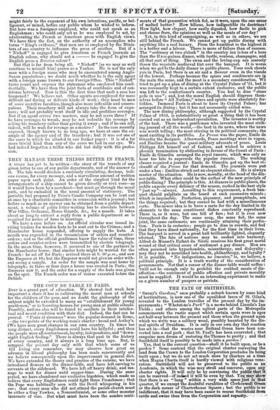THE FATE OF SMITHFIELD.
SnonT's Gardena," ones probably a suburb known by some kind of horticulture is now one of the squalidest lanes of St. Giles's, revealed to the London traveller of the present day by the im- provements ; "Whetstone's Park" is a mews behind Lincoln's Inn Fields ; and others among the ugliest parts of the Metropolis commemorate the rustic aspect which certain spots wore in ages not half-way between the present and those when the ground upon which we write was a solitary wood, possibly haunted by the dis- mal spirits of Druidism. It is only an our own day that reaction has set in—that the wastes near Bethnal Green have been con- verted into a real park ; that St. Paul's has been excavated ; that sanguine men dream of restoring the Thames to purity ; and that Smithfield itself is possibly to be made into a garden ! Yes, that is the current question—shall it be built upon, or be a garden ? Some contend that the original charter conveying the, land from the Crown to the London Corporation precludes its being built upon ; but we do not set much store by charters at a time when Magna Charts itself is hardly viewed with religious vene- ration. Smithfield will not be preserved to the public as an Academia, in which the wise may stroll and converse, upon any charter rights. It will only be by convincing the public that it can be reserved—if indeed it will be even by that. You may show that there is no " lung " within a very wide space just in that quarter, if we except the doubtful ruralities of Clerkenwell Green or the dark corner of Charterhouse Square ; but the public is so indifferent, that it may have been easier to rescue Smithfield from cattle and swine than from the Corporation and rapacity. To appropriate the ground, however, would really be to em- bezzle the resources of posterity; to keep it open, would be to fall in with the whole tendency of London improvement. Hitherto London seems to have spread entirely on the surface; it now be- gins to increase upwards. By a better economy of space more room is found without covering more• ground. Should the new plan of building, exemplified for working class and middle class zit Albert Buildings and Victoria Street, be carried on, we shall have the present houses of London replaced by handsomer and taller structures, with larger spaces between—broader streets and more frequent" lungs." This breadth of interstice is essential to the plan of taller buildings. Now there is no spot of ground more likely to be surrounded by improved buildings than Smithfield. It is near the great commercial centre, and would be an admirable site for such improvements; which would of course be created by degrees. And the market vacated by those fourfooted tenants who have removed to Copenhagen Fields is a ready-made lung—only awaiting gravel and a plantation. We look forward to the day when youthful pairs, strolling among the trees and shrubs of Smithfield, shall be interrupted in their interesting converse only by those troublesome children who are always in people's .way.



























 Previous page
Previous page